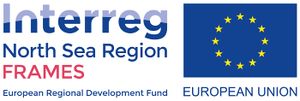(Dubbele div (emmskin-extra-row) verwijderd) |
Geen bewerkingssamenvatting |
||
| Regel 5: | Regel 5: | ||
Floods have always been and will continue to be part of our daily reality. In fact, floods are among the world’s most common and most devastating natural hazards and have affected millions of people in Europe since the beginning of this century. Changes in our climate are increasing the risk of river and coastal flooding because sea levels are rising and rainfall patterns are becoming more extreme. Increasing flood risks call for more innovative approaches to minimize the impacts of such events. Therefore, five countries bordering the North Sea Region, Denmark, Germany, the Netherlands, Belgium and the United Kingdom, are joining forces in the Interreg North Sea Region project FRAMES. | Floods have always been and will continue to be part of our daily reality. In fact, floods are among the world’s most common and most devastating natural hazards and have affected millions of people in Europe since the beginning of this century. Changes in our climate are increasing the risk of river and coastal flooding because sea levels are rising and rainfall patterns are becoming more extreme. Increasing flood risks call for more innovative approaches to minimize the impacts of such events. Therefore, five countries bordering the North Sea Region, Denmark, Germany, the Netherlands, Belgium and the United Kingdom, are joining forces in the Interreg North Sea Region project FRAMES. | ||
FRAMES stands for Flood Resilient Areas by Multi-layEred Safety. Traditionally, structural and static solutions were the preferred management option to defend against flooding. However, it is more and more recognized that protection alone will not be enough to make areas climate-resilient. It is also imperative to decrease the effects of flooding and look at spatial planning and disaster management as well. This so-called Multi-Layer Safety (MLS) approach is thus based on three layers: 1) protection, the primary dike system; 2) sustainable spatial planning that decreases the loss should a flood occur; and 3) disaster management, the organizational aspects related to a flood event. Together, these three layers can be tailored to local areas in order to minimize flood damage. | FRAMES stands for Flood Resilient Areas by Multi-layEred Safety. Traditionally, structural and static solutions were the preferred management option to defend against flooding. However, it is more and more recognized that protection alone will not be enough to make areas climate-resilient. It is also imperative to decrease the effects of flooding and look at spatial planning and disaster management as well. This so-called Multi-Layer Safety (MLS) approach is thus based on three layers: 1) protection, the primary dike system; 2) sustainable spatial planning that decreases the loss should a flood occur; and 3) disaster management, the organizational aspects related to a flood event. Together, these three layers can be tailored to local areas in order to minimize flood damage. | ||
The results of FRAMES (2016-2020) are highly relevant for policymakers and practitioners working on flood risk management on a local, regional and national scale. By clicking on the block below, you will be able to download our final reports, policy recommendations and layman's report, discover the details of all the 16 pilot projects, access the Decision Support System and Toolkit and look at communication materials. | |||
{{EMMskin Cards section | {{EMMskin Cards section | ||
| Regel 29: | Regel 31: | ||
| Project[Show sources]=Nee | | Project[Show sources]=Nee | ||
}} | }} | ||
--> | -->The FRAMES-video below explains Multi-Layer Safety in 90 seconds: | ||
The FRAMES-video below explains Multi-Layer Safety in 90 seconds: | |||
Versie van 21 apr 2020 07:23
FRAMES: Flood Resilient Areas by Multi-Layered Safety
Welcome to the wiki based platform of FRAMES
Floods have always been and will continue to be part of our daily reality. In fact, floods are among the world’s most common and most devastating natural hazards and have affected millions of people in Europe since the beginning of this century. Changes in our climate are increasing the risk of river and coastal flooding because sea levels are rising and rainfall patterns are becoming more extreme. Increasing flood risks call for more innovative approaches to minimize the impacts of such events. Therefore, five countries bordering the North Sea Region, Denmark, Germany, the Netherlands, Belgium and the United Kingdom, are joining forces in the Interreg North Sea Region project FRAMES.
FRAMES stands for Flood Resilient Areas by Multi-layEred Safety. Traditionally, structural and static solutions were the preferred management option to defend against flooding. However, it is more and more recognized that protection alone will not be enough to make areas climate-resilient. It is also imperative to decrease the effects of flooding and look at spatial planning and disaster management as well. This so-called Multi-Layer Safety (MLS) approach is thus based on three layers: 1) protection, the primary dike system; 2) sustainable spatial planning that decreases the loss should a flood occur; and 3) disaster management, the organizational aspects related to a flood event. Together, these three layers can be tailored to local areas in order to minimize flood damage.
The results of FRAMES (2016-2020) are highly relevant for policymakers and practitioners working on flood risk management on a local, regional and national scale. By clicking on the block below, you will be able to download our final reports, policy recommendations and layman's report, discover the details of all the 16 pilot projects, access the Decision Support System and Toolkit and look at communication materials.
Sjabloon:EMMskin Cards section
The FRAMES-video below explains Multi-Layer Safety in 90 seconds:

